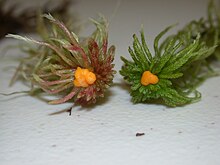Endogonales is an order of fungi within the phylum of Zygomycota,[2] and in class Endogonomycetes.[3][4]
| Endogonales | |
|---|---|

| |
| The fungus Endogone pisiformus | |
| Scientific classification | |
| Domain: | Eukaryota |
| Kingdom: | Fungi |
| Division: | Mucoromycota |
| Subdivision: | Mucoromycotina Moreau ex R.K. Benj |
| Order: | Endogonales Jacz. & P.A.Jacz.[1] |
| Families | |
| |
It contains 2 families; Endogonaceae, with 6 genera and 38 species and Densosporaceae, with one genera and 4 species.[3]
History edit
The Endogales were originally formed to hold a single family, the Endogonaceae, which comprised 15 species in four genera (Endogone, Peridiospora, Sclerogone, and Youngiomyces). They were transferred to the phylum Glomeromycota to Zygomycetes.[5] Then they were placed in Zygomycotina.[6] They were placed in the subphylum Mucoromycotina in 2017 and genus Youngiomyces was synonymized with genus Endogone.[7] They were then placed in the monotypic class Endogonomycetes.[4]
Genera edit
Endogonaceae Paol.;[8]
- Endogone Link (26 species)
- Jimgerdemannia Trappe, Desirò, M.E. Sm., Bonito & Bidartondo (3: Jimgerdemannia ambigua Koh. Yamam., Degawa & A. Yamada (2020), Jimgerdemannia flammicorona (Trappe & Gerd.) Trappe, Desirò, M.E. Sm., Bonito & Bonito & Bidart. (2017), Jimgerdemannia lactiflua (Berk. & Broome) Trappe, Desirò, M.E. Sm., Bonito & Bidart. (2017))
- Peridiospora C.G. Wu & Suh J. Lin (2: Peridiospora reticulata C.G. Wu & Suh J. Lin (1997) and Peridiospora tatachia C.G. Wu & Suh J. Lin (1997))
- Sclerogone Warcup (1: Sclerogone eucalypti Warcup (1990))
- Sphaerocreas Sacc. & Ellis (4)
- Vinositunica Koh. Yamam., Degawa & A. Yamada (2: Vinositunica ingens Koh. Yamam., Degawa & A. Yamada (2020) and Vinositunica radiata Koh. Yamam., Degawa & A. Yamada (2020))
Densosporaceae Desirò, M.E. Sm., Bidartondo, Trappe & Bonito;[9]
- Densospora McGee (4 Species: D. nanospora – D. nuda – D. solicarpa – D. tubiformis)
Note; genus Jimwhitea M. Krings & T.N. Taylor was placed in the Endogonaceae family, but holds only fossils reported from the Middle Triassic formations. So is placed in Ascomycota genera Incertae sedis.[3]
Life cycle edit
The life cycle of the Endogonales is distinguished by their production of small sporocarps containing many zygospores, which are eaten by rodents and distributed by their faeces.
They also produce a fetid odour that attracts mammals and encourages them to eat their fruiting bodies, and so spread their spores.[10]
Food edit
Like all fungi, they are heterotrophs with some being described as saprobes (with weak evidence).[10]
References edit
- ^ Jaczewski, A.A.; Jaczewski, P.A. (1931). "Определитель грибов. Совершенные грибы (диплоидные стадии). 3-е изд. [Вып. 1]. Фикомицеты. [Keys to Fungi. Perfect Fungi (diploid stages).". In Doweld, Alexander (ed.). Phycomycetes (in Russian) (3 ed.). Moscow-Leningrad: Gosudarstvennoe Izdateľstvo sel'skokhozjaistvennoj i kolkhozno-kooperativnoj literatury. p. 294.
- ^ Kirk PM, Cannon PF, Minter DW, Stalpers JA (2008). Dictionary of the Fungi (10th ed.). Wallingford: CABI. p. 233. ISBN 978-0-85199-826-8.
- ^ a b c Wijayawardene, Nalin; Hyde, Kevin; Al-Ani, Laith Khalil Tawfeeq; Somayeh, Dolatabadi; Stadler, Marc; Haelewaters, Danny; et al. (2020). "Outline of Fungi and fungus-like taxa". Mycosphere. 11: 1060–1456. doi:10.5943/mycosphere/11/1/8. hdl:10481/61998.
- ^ a b Doweld, A.B. (2014). "Nomenclatural novelties: Endogonomycetes cl. nov". Index fungorum. 57: 1.
- ^ Voigt, K.; Kirk, P.M. (2014). "FUNGI | Classification of Zygomycetes". In Batt, Carl A.; Tortorello, Mary Lou (eds.). Encyclopedia of Food Microbiology (2nd ed.). Academic Press. ISBN 978-0-12-384733-1.
- ^ Yao, Y.J.; Pegler, D.N.; Young, T.W.K. (1995). "Youngiomyces, a new genus in Endogonales (Zygomycotina)". Kew Bulletin. 50: 349–357.
- ^ Desirò, Alessandro; Rimington, William R.; Jacob, Alison; Pol, Natalie Vande; Smith, Matthew E.; Trappe, James M.; Bidartondo, Martin I.; Bonito, Gregory (December 2017). "Multigene phylogeny of Endogonales, an early diverging lineage of fungi associated with plants". IMA Fungus. 8 (2): 245–257. doi:10.5598/imafungus.2017.08.02.03. hdl:10044/1/55563. PMID 29242774.
- ^ "Family Names". www.speciesfungorum.org. Retrieved 5 October 2022.
- ^ "Family Names". www.speciesfungorum.org. Retrieved 5 October 2022.
- ^ a b C.J. Alexopolous, Charles W. Mims, M. Blackwell et al., Introductory Mycology, 4th ed. (John Wiley and Sons, Hoboken NJ, 2004) ISBN 0-471-52229-5